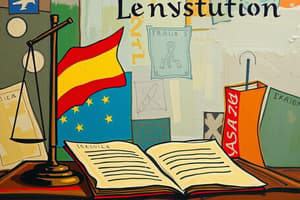Podcast
Questions and Answers
Chapter 4 provides guarantees for social and economic policy rights.
Chapter 4 provides guarantees for social and economic policy rights.
False (B)
The Cortes Generales consists of the Congress of Deputies and the Senate.
The Cortes Generales consists of the Congress of Deputies and the Senate.
True (A)
Title 7 addresses the judiciary system of Spain.
Title 7 addresses the judiciary system of Spain.
False (B)
Chapter 3 in Title 8 focuses on local administration.
Chapter 3 in Title 8 focuses on local administration.
Title 10 outlines the procedures for constitutional reform.
Title 10 outlines the procedures for constitutional reform.
The Spanish Constitution was approved by the Spanish Parliament on December 6, 1978.
The Spanish Constitution was approved by the Spanish Parliament on December 6, 1978.
The dogmatic part of the Spanish Constitution focuses on the functioning of different powers and institutions.
The dogmatic part of the Spanish Constitution focuses on the functioning of different powers and institutions.
The preliminary title of the Constitution recognizes the right to autonomy for different territories.
The preliminary title of the Constitution recognizes the right to autonomy for different territories.
The Spanish Constitution was ratified by the Spanish people in a referendum.
The Spanish Constitution was ratified by the Spanish people in a referendum.
Titles 2-10 of the Spanish Constitution fall under the dogmatic part.
Titles 2-10 of the Spanish Constitution fall under the dogmatic part.
Spanish is the official language of the State according to Article 3 of the Constitution.
Spanish is the official language of the State according to Article 3 of the Constitution.
The Spanish Constitution consists of 200 articles.
The Spanish Constitution consists of 200 articles.
The principle of political pluralism is recognized in the Spanish Constitution.
The principle of political pluralism is recognized in the Spanish Constitution.
El Título 3 de la Constitución se ocupa de la economía y la política social.
El Título 3 de la Constitución se ocupa de la economía y la política social.
El Capítulo 1 del Título 5 trata sobre las garantías de derechos y libertades fundamentales.
El Capítulo 1 del Título 5 trata sobre las garantías de derechos y libertades fundamentales.
El Título 8 está dedicado a la organización territorial del Estado.
El Título 8 está dedicado a la organización territorial del Estado.
La Sección 2 del Capítulo 2 regula solo los derechos de los ciudadanos.
La Sección 2 del Capítulo 2 regula solo los derechos de los ciudadanos.
El Título 9 de la Constitución se refiere al Gobierno y la Administración.
El Título 9 de la Constitución se refiere al Gobierno y la Administración.
La Constitución Española de 1978 fue sancionada por el Rey el 31 de octubre de 1978.
La Constitución Española de 1978 fue sancionada por el Rey el 31 de octubre de 1978.
La Constitución Española incluye un preámbulo y tiene 169 artículos.
La Constitución Española incluye un preámbulo y tiene 169 artículos.
El título preliminar de la Constitución regula las banderas de España.
El título preliminar de la Constitución regula las banderas de España.
La parte dogmática de la Constitución contiene las reglas sobre el funcionamiento de los poderes del estado.
La parte dogmática de la Constitución contiene las reglas sobre el funcionamiento de los poderes del estado.
Los derechos fundamentales se encuentran en el Título 2 de la Constitución Española.
Los derechos fundamentales se encuentran en el Título 2 de la Constitución Española.
El artículo 9 de la Constitución asegura que tanto los ciudadanos como los poderes públicos están sujetos a ella.
El artículo 9 de la Constitución asegura que tanto los ciudadanos como los poderes públicos están sujetos a ella.
El castellano es la única lengua oficial del estado según la Constitución.
El castellano es la única lengua oficial del estado según la Constitución.
La Constitución Española de 1978 fue publicada en el Boletín Oficial del Estado el 29 de diciembre de 1978.
La Constitución Española de 1978 fue publicada en el Boletín Oficial del Estado el 29 de diciembre de 1978.
La Constitución Española fue aprobada el 31 de octubre de 1980.
La Constitución Española fue aprobada el 31 de octubre de 1980.
La Parte Dogmática de la Constitución se ocupa del funcionamiento de los poderes del Estado.
La Parte Dogmática de la Constitución se ocupa del funcionamiento de los poderes del Estado.
El Título IV de la Constitución está dedicado a la organización territorial del Estado.
El Título IV de la Constitución está dedicado a la organización territorial del Estado.
El Derecho a las Autonomías está incluido en el Título Preliminar de la Constitución.
El Derecho a las Autonomías está incluido en el Título Preliminar de la Constitución.
El Título II trata sobre los españoles y extranjeros.
El Título II trata sobre los españoles y extranjeros.
La Constitución incluye un total de diez títulos.
La Constitución incluye un total de diez títulos.
Las Fuerzas Armadas tienen una misión definida en la parte orgánica de la Constitución.
Las Fuerzas Armadas tienen una misión definida en la parte orgánica de la Constitución.
La Constitución Española permite el reconocimiento de lenguas oficiales en comunidades autónomas.
La Constitución Española permite el reconocimiento de lenguas oficiales en comunidades autónomas.
Flashcards
Spanish Parliament
Spanish Parliament
The Spanish Parliament, called Cortes Generales, is the legislative branch of the Spanish government.
Spanish Constitution - Title 8
Spanish Constitution - Title 8
Title 8 in the Spanish Constitution outlines the territorial organization of Spain. It covers general principles, local administration, and autonomous communities.
Constitutional Court function
Constitutional Court function
The Constitutional Court, covered in Title 9, ensures Spain's laws follow the Constitution. It interprets and applies its rules.
Government-Parliament Relationship
Government-Parliament Relationship
Signup and view all the flashcards
Title 2 of Constitution
Title 2 of Constitution
Signup and view all the flashcards
Spanish Constitution
Spanish Constitution
Signup and view all the flashcards
Dogmatic Part
Dogmatic Part
Signup and view all the flashcards
Organic Part
Organic Part
Signup and view all the flashcards
Sovereignty of the State
Sovereignty of the State
Signup and view all the flashcards
Fundamental Rights
Fundamental Rights
Signup and view all the flashcards
Official Language of Spain
Official Language of Spain
Signup and view all the flashcards
Political Pluralism
Political Pluralism
Signup and view all the flashcards
Hierarchy of Norms
Hierarchy of Norms
Signup and view all the flashcards
Constitución Española de 1978
Constitución Española de 1978
Signup and view all the flashcards
Título Preliminar
Título Preliminar
Signup and view all the flashcards
¿Qué establece la Constitución Española?
¿Qué establece la Constitución Española?
Signup and view all the flashcards
Parte Dogmática
Parte Dogmática
Signup and view all the flashcards
Parte Orgánica
Parte Orgánica
Signup and view all the flashcards
Soberanía
Soberanía
Signup and view all the flashcards
Lenguas Oficiales
Lenguas Oficiales
Signup and view all the flashcards
Título 1: De los derechos y libertades
Título 1: De los derechos y libertades
Signup and view all the flashcards
¿Qué garantiza el artículo 9 de la Constitución?
¿Qué garantiza el artículo 9 de la Constitución?
Signup and view all the flashcards
Título 3: De las Cortes Generales
Título 3: De las Cortes Generales
Signup and view all the flashcards
Título 7: Del Consejo de Estado y de la Hacienda Pública
Título 7: Del Consejo de Estado y de la Hacienda Pública
Signup and view all the flashcards
Título 9: Del Tribunal Constitucional
Título 9: Del Tribunal Constitucional
Signup and view all the flashcards
Título 10: De la reforma constitucional
Título 10: De la reforma constitucional
Signup and view all the flashcards
Constitución Española
Constitución Española
Signup and view all the flashcards
Soberanía Popular
Soberanía Popular
Signup and view all the flashcards
Derechos y Deberes Fundamentales
Derechos y Deberes Fundamentales
Signup and view all the flashcards
Título VIII: Organización Territorial
Título VIII: Organización Territorial
Signup and view all the flashcards
Study Notes
The Spanish Constitution
- The Spanish Constitution is the supreme law of the Spanish legal system.
- It was approved by the Spanish Parliament (Cortes Generales) on October 31, 1978.
- It was ratified by the Spanish people in a referendum on December 6, 1978.
- It was sanctioned by King Juan Carlos I on December 27, 1978.
- It was published in the Official State Gazette (BOE) on December 29, 1978.
- The Constitution follows the traditional model of a written constitution.
- It consists of 169 articles divided into a preamble, a preliminary title, 10 titles, four additional provisions, nine transitional provisions, one repealing provision, and one final provision.
- The Constitution is divided into a dogmatic part and an organic part.
The Dogmatic Part
- The dogmatic part consists of the declaration of fundamental rights and duties and a series of social and economic principles.
- This encompasses the preliminary title and Title 1.
The Organic Part
- The organic part establishes the rules governing the functioning of the different powers and institutions.
- This encompasses Titles 2-10.
Preliminary Title
- The preliminary title establishes the general principles that govern the Spanish legal system and the institutions of the State.
- Article 1: The sovereignty of the State resides in the people, and the unity of the nation is recognized.
- Article 2: The right to autonomy for the different territories is recognized.
- Article 3: Spanish is the official language of the State, and other languages are recognized in their respective autonomous communities.
- Article 4: The flag of Spain is regulated.
- Article 5: The capital of the State is Madrid.
- Article 6: Political pluralism, trade unions, and employers' associations are recognized.
- Article 7: The Armed Forces are tasked with defending the constitutional order.
- Article 9:
- Both citizens and public authorities are subject to the Constitution and the rest of the legal system.
- The right to real and effective equality is recognized.
- The principles of legality, hierarchy of norms, the publicity of norms, the non-retroactivity of unfavorable or restrictive sanctions, the security of legal rights, accountability, and the prohibition of arbitrariness of public powers are guaranteed.
Title 1: Rights and Fundamental Freedoms
- Chapter 1: Deals with Spaniards and foreigners.
- Chapter 2: Regulates rights and freedoms.
- Section 1: Fundamental rights and public freedoms.
- Section 2: Rights and duties of citizens.
- Chapter 3: Regulates the guiding principles of social and economic policy.
- Chapter 4: Provides guarantees of freedoms and fundamental rights.
- Chapter 5: Establishes the suspension of rights and freedoms.
Title 2: The Crown
- Title 2 deals with the Crown of Spain.
Title 3: The Cortes Generales
- Title 3 deals with the Spanish Parliament (Cortes Generales).
- Chapter 1: The Chambers (Congress of Deputies and Senate).
- Chapter 2: Elaboration of laws.
- Chapter 3: International treaties.
Title 4: The Government and Administration
- Title 4 deals with the government and administration.
Title 5: Relations Between the Government and the Cortes Generales
- Title 5 deals with the relationship between the government and the Cortes Generales.
Title 6: The Judiciary
- Title 6 deals with the judicial branch of the Spanish government.
Title 7: The General Budget and Public Finances
- Title 7 deals with the general budget and public finances.
Title 8: Territorial Organisation of the State
- Chapter 1: General principles.
- Chapter 2: Local administration.
- Chapter 3: Autonomous communities.
Title 9: The Constitutional Court
- Title 9 deals with the Constitutional Court.
Title 10: Constitutional Reform
- Title 10 deals with the process of reforming the Constitution.
Studying That Suits You
Use AI to generate personalized quizzes and flashcards to suit your learning preferences.




